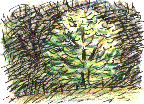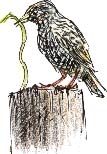Fresh LeafWednesday, 8th May 2002, West Yorkshire |
![]()
![]()
![]()
![]() Rocks |
History |
Workshop |
Links |
Home Page
Rocks |
History |
Workshop |
Links |
Home Page
![]()

The three fledglings are learning a lot about blackbird life, not least about the constant vigilance needed to protect a territory.
 It's a dull day again but at lunchtime I notice a large tree at the edge of the wood that appears so bright that at first I think it's covered with some kind of yellow and white blossom. In a uniformly dulled down landscape a wormhole has opened in the cloud cover to allow a beam of light no larger than a single tree to move slowly across the band of woodland.
It's a dull day again but at lunchtime I notice a large tree at the edge of the wood that appears so bright that at first I think it's covered with some kind of yellow and white blossom. In a uniformly dulled down landscape a wormhole has opened in the cloud cover to allow a beam of light no larger than a single tree to move slowly across the band of woodland.Just as I'm beginning to realise that this is nothing more than a sycamore bedecked with grape-like clusters of yellow-green blossom the beam moves on. I feel a bit of a sigh of disappointment as the glorious vision fades and the bare ashes and budding oaks behind take their brief turns in the spotlight.
Natural Insecticide

 A starling bathes enthusiastically as the edge of the pond. It's one way of keeping feather mites and other hangers on in check. Later as one starling is joined by another on top of a telephone pole down the road the first bird drops the wisp of grass it has been carrying in its beak. The leaf falls to the pavement at my feet and I'm surprised to see that it's fresh and green. I would have thought dried grass would be the regular choice for nest-building.
A starling bathes enthusiastically as the edge of the pond. It's one way of keeping feather mites and other hangers on in check. Later as one starling is joined by another on top of a telephone pole down the road the first bird drops the wisp of grass it has been carrying in its beak. The leaf falls to the pavement at my feet and I'm surprised to see that it's fresh and green. I would have thought dried grass would be the regular choice for nest-building.Here's what the Cornell Lab of Ornithology has to say about starlings' nests in North America;
The cup of the nest is constructed of coarse grass, twigs, pine needles, rootlets, and straw and is lined with moss, feathers, wool, and fresh leaves. These leaves are replaced frequently and are believed to function as a natural insecticide or bactericide.The John Downer's current BBC film series Weird Nature, which explores strange animal behaviour, goes further and suggests that some of these fresh leaves provide aromatherapy for the developing embryos in their eggs, giving the chicks a competitive edge in the stressful world they'll face outside the nest.
I just hope that the starlings that sometimes nest in the corner of our roof don't start playing new age music to their brood.
 House sparrows occupy that corner spot this year and I've seen them chase off a starling that poked its beak into the nest entrance. A line of sparrow droppings now extends across the garage roof below, across the drive . . . and onto the car which I've just washed. Over the years a patch of yellow and grey lichens has developed below the nest hole.
House sparrows occupy that corner spot this year and I've seen them chase off a starling that poked its beak into the nest entrance. A line of sparrow droppings now extends across the garage roof below, across the drive . . . and onto the car which I've just washed. Over the years a patch of yellow and grey lichens has developed below the nest hole.  Two wood pigeons look as if they have nest-making in mind as they sit together in the top of a bare lofty ash.
Two wood pigeons look as if they have nest-making in mind as they sit together in the top of a bare lofty ash.Related Link
Cornell Lab of Ornithology![]()
Richard Bell,
wildlife illustrator
E-mail; 'richard@willowisland.co.uk'
![]() Next page
Previous page |
This day in 2000 |
This month
Nature Diary |
Home Page
Next page
Previous page |
This day in 2000 |
This month
Nature Diary |
Home Page
![]()